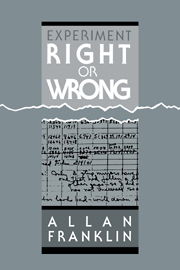Summary
The title of this book might suggest an unthinking adherence to the roles of experiment in science and an unquestioned faith in experimental results. This is not the conclusion I want the reader to reach. At the very least, the reader should firmly believe in both the fallibility and the corrigibility of science. I also want the reader to be persuaded that the evidence model, in which questions of theory choice, confirmation of theory, or refutation of theory are decided on the basis of valid experimental evidence, is both an accurate description of the way science is practiced, and a philosophically justified view.
There are episodes in which the experimental results are still unchallenged and regarded as correct. Thus, the experiments of Wu, Ambler, Hayward, Hoppes, and Hudson; of Garwin, Lederman, and Weinrich; and of Friedman and Telegdi provided the crucial evidence that established the hypothesis of parity nonconservation, suggested by Lee and Yang. The discovery of parity nonconservation played an essential role in the development of the V-A theory of weak interactions. It was also incorporated into the Weinberg-Salam theory the successor to the V-A theory. The experiments on atomic parity violation were regarded as extremely important, if not crucial, tests of that theory. I suspect that had the results not agreed with the Weinberg-Salam theory the theory would have been discarded, or at least severely modified.
- Type
- Chapter
- Information
- Experiment, Right or Wrong , pp. 193 - 197Publisher: Cambridge University PressPrint publication year: 1990



